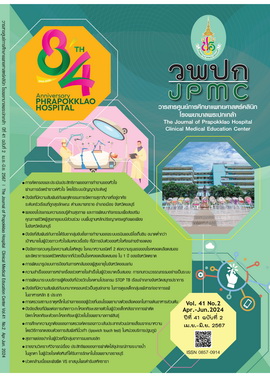ปัจจัยที่สัมพันธ์กับการได้รับยากลุ่มยับยั้งการทำงานของระบบเรนินแอนจิโอเท็นซินขนาดต่ำกว่าเป้าหมายในผู้ป่วยภาวะหัวใจล้มเหลวเรื้อรังที่มีการบีบตัวของหัวใจห้องล่างซ้ายลดลง
Main Article Content
บทคัดย่อ
ที่มาของปัญหา: แนวทางเวชปฏิบัติในปัจจุบันแนะนำให้ผู้ป่วยภาวะหัวใจล้มเหลวที่มีการบีบตัวของหัวใจห้องล่างซ้ายลดลง ควรได้รับยากลุ่ม Angiotensin converting enzyme inhibitors (ACEIs) หรือ Angiotensin receptor-neprilysin inhibitors (ARNI) หรือ Angiotensin receptor blockers (ARBs) ในขนาดเป้าหมาย เนื่องจากมีหลักฐานเชิงประจักษ์ว่าสามารถลดอัตราการเสียชีวิตและอัตราการนอนโรงพยาบาลได้ แต่ผู้ป่วยส่วนใหญ่ยังคงได้รับการปรับขนาดยาเหล่านี้ไม่ถึงเป้าหมาย ปัจจุบันในประเทศไทยยังไม่มีการศึกษาเพื่อหาปัจจัยที่สัมพันธ์กับการได้รับยากลุ่มนี้ขนาดต่ำกว่าเป้าหมาย
วัตถุประสงค์: เพื่อหาปัจจัยที่สัมพันธ์กับการได้รับยากลุ่ม ACEIs/ARBs/ARNI ขนาดต่ำกว่าเป้าหมาย ในผู้ป่วยคนไทยภาวะหัวใจล้มเหลวเรื้อรังที่มีการบีบตัวของหัวใจห้องล่างซ้ายลดลง
วิธีการศึกษา: การวิจัยเชิงวิเคราะห์จากเหตุไปหาผลแบบย้อนหลัง ในผู้ป่วยคนไทยภาวะหัวใจล้มเหลวเรื้อรังที่มีการบีบตัวของหัวใจห้องล่างซ้ายลดลง แผนกผู้ป่วยนอก โรงพยาบาลตราด และโรงพยาบาลพระปกเกล้า ตั้งแต่มกราคม พ.ศ. 2559 ถึงธันวาคม พ.ศ. 2563 โดยใช้แบบบันทึกข้อมูลผู้ป่วย แล้ววิเคราะห์ปัจจัยที่สัมพันธ์กับการได้รับยาในกลุ่ม ACEIs/ARBs/ARNI ขนาดต่ำกว่าเป้าหมายด้วยสถิติการถดถอยโลจิสติก
ผลการศึกษา: การศึกษานี้มีผู้ป่วยจำนวน 396 ราย แบ่งเป็นกลุ่มที่ได้รับยา ACEIs/ARBs/ARNI ขนาดต่ำกว่าเป้าหมาย 289 ราย และกลุ่มที่ได้รับยา ACEIs/ARBs/ARNI ขนาดมากกว่าหรือเท่ากับเป้าหมาย 107 ราย เมื่อควบคุมปัจจัยอื่นๆ ที่ศึกษา พบว่าปัจจัยที่มีความสัมพันธ์กับการได้รับยาขนาดต่ำกว่าเป้าหมาย คือ New York Heart Association (NYHA) class III/IV (odd ratio 1.75; 95%CI 1.06-2.88, p=0.03) และการได้รับยากลุ่ม Beta-blockers ขนาดมากกว่าหรือเท่ากับร้อยละ 50 ของขนาดเป้าหมาย (odd ratio 0.37; 95%CI 0.23-0.61, p<0.001)
สรุป: ปัจจัย NYHA class III/IV เพิ่มความเสี่ยงที่ผู้ป่วยจะได้รับยาขนาดต่ำกว่าเป้าหมาย ในขณะที่การได้รับยากลุ่ม Beta-blockers ขนาดมากกว่าหรือเท่ากับร้อยละ 50 ของขนาดเป้าหมาย ช่วยลดความเสี่ยงที่จะทำให้ผู้ป่วยได้รับยาในกลุ่ม ACEIs/ARBs/ARNI ขนาดต่ำกว่าเป้าหมาย ซึ่งเป็นปัจจัยที่สามารถเปลี่ยนแปลงได้
ClinicalTrials.gov Identifier, NCT06382571
Article Details

อนุญาตภายใต้เงื่อนไข Creative Commons Attribution-NonCommercial-NoDerivatives 4.0 International License.
เอกสารอ้างอิง
Mc Donagh TA, Metra M, Adamo M, Gardner RS, Baumbach A, Böhm M, et al. 2021 ESC guidelines for the diagnosis and treatment of acute and chronic heart failure: developed by the task force for the diagnosis and treatment of acute and chronic heart failure of the European Society of Cardiology (ESC) with the special contribution of the Heart Failure Association (HFA) of the ESC. Eur Heart J 2021;42:3599–726.
Heidenreich PA, Bozkurt B, Aguilar D, Allen LA, Byun JJ, Colvin MM, et al. 2022 AHA/ACC/HFSA guideline for the management of heart failure: a report of the american college of cardiology/american heart association joint committee on clinical practice guidelines. Circulation [Internet]. 2022 [cited 2023 Oct 15];145(18):e895-e1032. Available from: https://www.ahajournals.org/doi/epdf/10.1161/CIR.0000000000001063
Ouwerkerk W, Teng TK, Tromp J, Tay WT, Cleland JG, van Veldhuisen DJ, et al. Effects of combined renin-angiotensin aldosterone system inhibitor and beta-blocker treatment on outcomes in heart failure with reduced ejection fraction: insights from BIOSTAT-CHF and ASIAN-HF registries. Eur J Heart Fail 2020;22:1472-82.
Greene SJ, Fonarow GC, DeVore AD, Sharma PP, Vaduganathan M, Albert NM, et al. Titration of medical therapy for heart failure with reduced ejection fraction. J Am Coll Cardiol 2019;73:2365-83.
Greene SJ, Tan X, Yeh YC, Bernauer M, Zaidi O, Yang M, et al. Factors associated with non-use and sub-target dosing of medical therapy for heart failure with reduced ejection fraction. Heart Fail Rev 2022;27:741-53.
Ter Maaten JM, Martens P, Damman K, Dickstein K, Ponikowski P, Lang CC, et al. Higher doses of loop diuretics limit uptitration of angiotensin-converting enzyme inhibitors in patients with heart failure and reduced ejection fraction. Clin Res Cardiol 2020;109:1048-59.
Hemapanpairoa J, Khongmee T, Priksri W, Intarachumnum S, Hongsumrite C, Prompaison S, et al. The prevalence and characteristic of patients achieve target doses of medications used to treat heart failure with reduced ejection fraction at heart failure clinic. The Bangkok Medical Journal 2022;18:83-7.
Hosmer D, Lemeshow S. Applied logistic regression. 2rd ed. New York: John Wiley & Sons; 2000.
Greene SJ, Butler J, Albert NM, DeVore AD, Sharma PP, Duffy CI, et al. Medical therapy for heart failure with reduced ejection fraction: the CHAMP-HF registry. J Am Coll Cardiol 2018;72:351-66.
Ouwerkerk W, Voors AA, Anker SD, Cleland JG, Dickstein K, Filippatos G, et al. Determinants and clinical outcome of uptitration of ACE-inhibitors and beta-blockers in patients with heart failure: a prospective European study. Eur Heart J 2017;38:1883-90.
Parker RB, Nappi JM, Cavallari LH. Chronic heart failure. In: DiPiro JT, Yee GC, Posey LM, Haines ST, Nolin TD, Ellingrod V, editors. Pharmacotherapy: a pathophysiologic approach. 11th ed. New York: McGraw-Hill Education; 2020. p.191-220.

